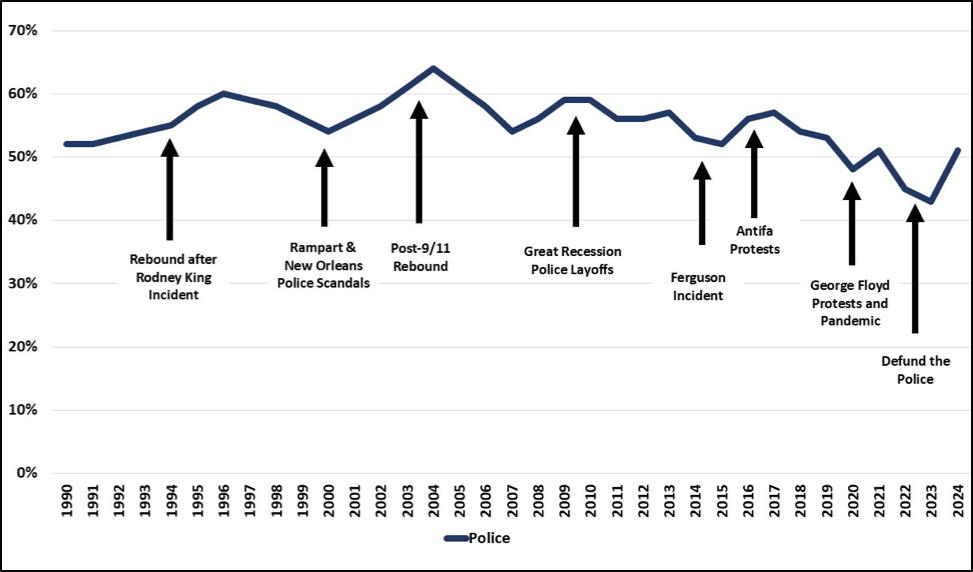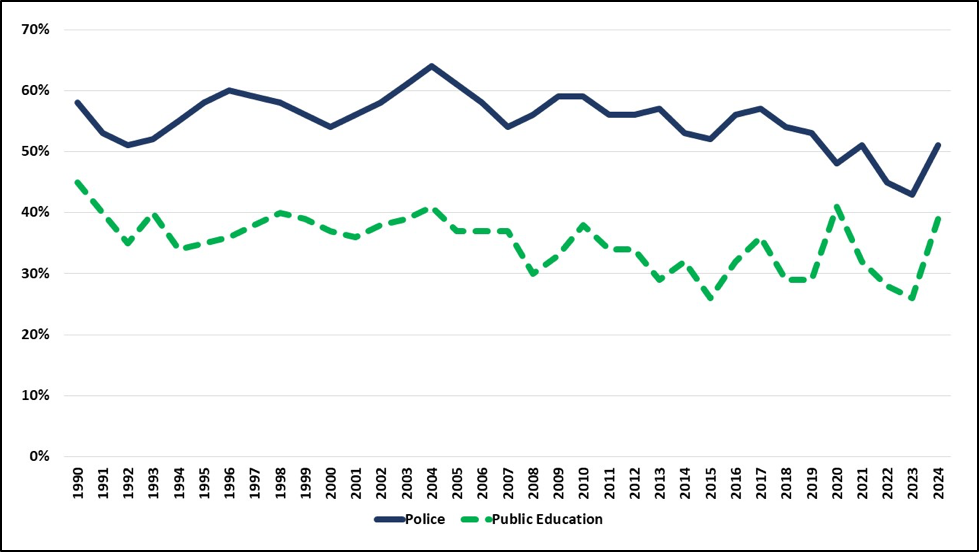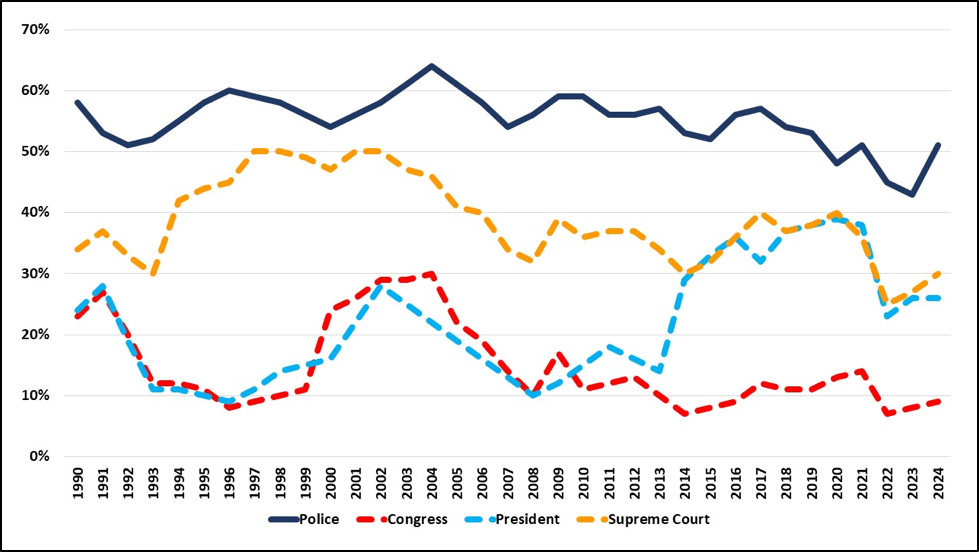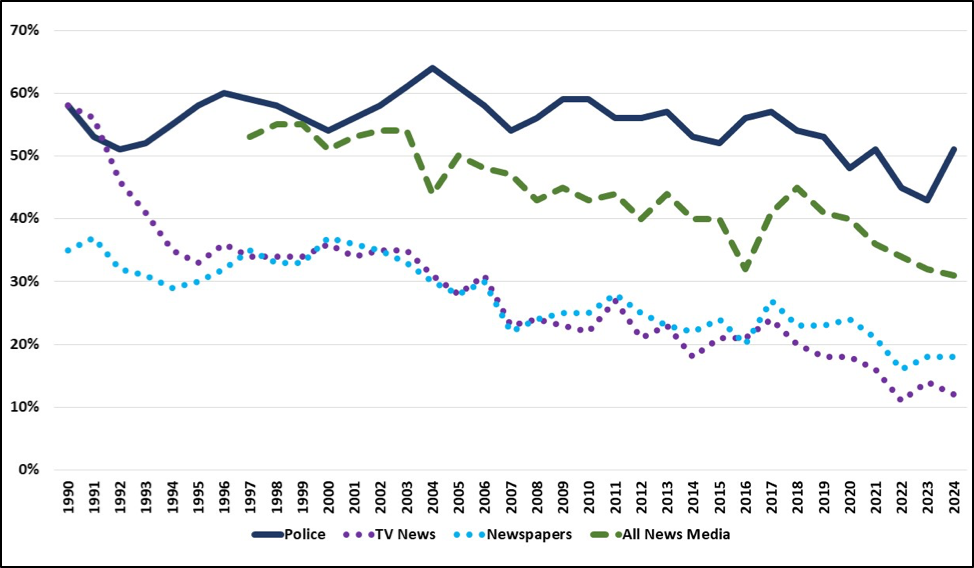November, 2024
In the summer of 2018, we published an article entitled The Public’s Confidence in the Police Might Be Better Than You Think that revealed two things. First, while there is always year-to-year fluctuation in public support for the police as news events sway public opinion, the overall rate of support for the police has remained fairly consistent, somewhere between 50% and 60%, for many decades. Second, compared to other social institutions—public education, congress, the presidency, the supreme court, or the news media—support for the police has been much higher for quite some time, and remains higher.
We published that article more than six years ago, before the civil unrest and George Floyd protests of the early 2020s. As we approach the midpoint of the decade, how is the law enforcement profession doing in the eyes of the American public?
Just as we did in our previous article, we rely on Gallup Poll data to address this question. The Gallup Poll conducts online and phone surveys of a random sample of roughly 2,000 persons in the United States every two weeks, selecting a different sample of 2,000 people each two-week period.
The graph in Figure 1 below shows the 35-year trend in Gallup Poll data on public confidence in the local police from 1990 through the first half of 2024. This graph demonstrates the percentage of Americans surveyed by the Gallup Organization who indicated that they had “a great deal” or “quite a lot” of confidence in their local police, year by year. As one can see, when massive and sensational news coverage focuses on a case of alleged police misconduct or corruption, public confidence in the police declines for a couple of years before rebounding. When the nation begins to remember why it needs the police, such as after mass police layoffs or when violent protests erupt, public confidence rises again. The data reveal that 2024 has seen a strong rebound in public confidence in their local police.
Figure 1. Gallup Poll Data on Public Confidence in the Police (1990-2024)

Source: Dolan Consulting Group LLC with Gallup data
What is most interesting about this 2024 rebound in public confidence in the local police is the demographic makeup of people whose attitudes have improved. According to Gallup, those who have historically expressed the highest confidence in the local police have been political conservatives, persons over the age of 55, and Whites. A Gallup study compared the 2023 to the 2024 data and revealed that the recent increases in public confidence in the local police have occurred most among persons aged 18-34 (a 59% increase), persons of color (a 42% increase), and political independents (a 32% increase).[1]
One plausible explanation for this demographic breakdown in support for the police is found in examining who is impacted most by crime, and who is most reliant on the help of local police. Crime in the United States disproportionately impacts young adult men in communities of color–demographics that correspond with the greatest surges in support for local police.[2] In other words, those members of the public with the greatest confidence in their local police are found in the demographic categories most likely to be victims of crime.[3]
While those of us who believe in the vital mission of law enforcement officers would like to see these public trust numbers go even higher, Americans have an inherent mistrust of all government institutions, which inevitably impacts their trust in the police. Numerous surveys that have compared American attitudes with those of other Western democracies, such as Great Britain, France, Germany, Spain, and Japan, consistently reveal that Americans have the greatest sense of cynicism toward government institutions.[4]
So how does public confidence in law enforcement stack up against public confidence in other government institutions? Law enforcement in the U.S. is overwhelmingly a local government function, with 90% of law enforcement officers employed at the municipal or county level.[5] The only other local government institution consistently included in Gallup Poll public confidence surveys has been public education. So how does public confidence in law enforcement compare to public confidence in public education since 1994?
Figure 2 compares the trend in public confidence in the police, with public confidence in public education, from 1990 through the first half of 2024. As this graph reveals, public confidence in public education has had year-to-year fluctuations that somewhat mirror public confidence in the local police. However, public confidence in public education has consistently been far below that of local law enforcement.
Figure 2. Gallup Poll Data on Public Confidence in Police and Public Education (1990-2024)

Source: Dolan Consulting Group LLC with Gallup data
Since the early 1990s, public education has struggled to reach the 40% confidence mark. In the wake of the pandemic, public confidence in public education plummeted below 30%. Even at its lowest points, public confidence in local police has been almost 15 percentage points higher than public confidence in public education. This is particularly striking when we note that local law enforcement agencies are routinely impacted by police misconduct that occurs hundreds or thousands of miles away, while this is rarely, if ever, true of local schools.
What about other government institutions? Public education and local law enforcement are the only local government institutions that the Gallup Organization tracks with its public confidence surveys. It does, however, track several federal government institutions including the Congress, the President, and the U.S. Supreme Court. How does public confidence in the police compare to public confidence in these three pillars of our national government?
Figure 3 below reveals the levels of public confidence in the police alongside the levels of public confidence in Congress, the President, and the Supreme Court. As this graph reveals, since 1990, public confidence in law enforcement has remained much higher than public confidence in the three pillars of the federal government. Even at its worst, public confidence in the police has been almost 20 percentage points higher than public confidence in the Supreme Court or the President at their best. In the first half of 2024, public confidence in the local police was 43 percentage points higher than public confidence in Congress! One would think this finding would merit some national news attention.
Figure 3. Gallup Poll Public Confidence in Police and Federal Government (1990-2024)

Source: Dolan Consulting Group LLC with Gallup data
Of course, the law enforcement profession should continue to work hard to improve its image among the American public. Nevertheless, compared to other government institutions at the local and national level, it appears that the law enforcement profession is doing well in terms of overall public confidence.
But for countless members of law enforcement, it doesn’t seem like the public confidence in the police is high. Negative media coverage of the police is undoubtedly a factor in this perception among officers. This is ironic, in light of the fact that the American public’s confidence in the news media is substantially lower than its confidence in the police.
Our final graph in Figure 4 compares the Gallup Poll data on public confidence in the police, with Gallup Poll data on public confidence in the television news media, newspapers, and in the mass news media in general. Television news media refers to all news outlets that began as a television station, either on antenna broadcast or cable television. This includes the news branches of ABC, CBS, NBC, FOX, CNN, MSNBC, Uniden, Telemundo, RT, Al-Jazeera, and the like. The newspaper category refers to newspapers in either print or online format. The final category refers to all news media in general, whether distributed via print, television, radio, podcast, social media, or online. Data in this last category has only been available since 1997.
Figure 4. Gallup Poll Public Confidence in Police and News Media (1990-2024)

Source: Dolan Consulting Group LLC with Gallup data
Since the mid-1990s, the American public has had greater confidence in local law enforcement than in any form of news media. Note that this is not a measure of readership or viewership. Of course, with the expansion of the internet there has been declining readership for print newspapers and viewership of television news broadcasts. But this is a survey of whether Americans trust these institutions to do their jobs and do them competently. Trust in newspapers was well below 50% before the 1990s began, and television news plummeted to the level of newspapers by the end of the 1990s. Confidence in both of these news sources has continued to decline over the last two-and-a-half decades. In the wake of the pandemic and the 2020 election, public confidence in television news fell below 20%, and public confidence in newspapers fell to 11%.
Most people would consider it a crisis if only about 1 in 10 people in a democracy trusted their free press. As of the first half of 2024, public confidence in the local police was more than 30 percentage points higher than confidence in television news, and almost 40 percentage points higher than confidence in newspapers. The birth of more independent, purely online news sources has contributed to the higher confidence ratings for the general mass news media.[6] Nevertheless, even this category remains in decline and lags behind the local police by 20 percentage points. It may well be time for the news media to take a long hard look at its own practices, and its own public confidence crisis, before spending quite so much time and effort decrying the public’s supposed lack of trust in the law enforcement profession.
In summary, public confidence in the police has remained fairly stable over the last 35 years, mostly fluctuating between 50% and 60% from year to year. While it is vital that police leaders continually work to improve public trust in law enforcement, confidence in the police has remained much higher than public confidence in most other government institutions, including public education, Congress, the President, and the Supreme Court. Finally, for almost four decades, public confidence in all news media sources has been declining and is significantly lower than the level of public confidence in law enforcement.
For law enforcement officers in the field, this data indicates that (1) there is a great deal of public trust to be protected through the diligent work in which officers engage on a daily basis in the communities that they protect and serve, and (2) officers should be very wary of letting institutions that lack public trust themselves to define their work and their profession.
References
[1] Brenan, M. (2024, July 15). U.S. Confidence in Institutions Mostly Flat, but Police Up: Average Confidence in Institutions Remains Historically Low, at 28%. Gallup Organization. Accessed at: https://news.gallup.com/poll/647303/confidence-institutions-mostly-flat-police.aspx
[2] Seifert, D., Andrea Lambe, Sven Anders, Klaus Pueschel, and A. Heinemann. (2009). Quantitative Analysis of Victim Demographics and Injury Characteristics at a Metropolitan Medico-Legal Center. Forensic Science International 188, (1-3): 46-51; Varline, Jayden (2024). Crime Incidents and Victim Demographics: An Examination of Reporting Behaviours. Journal of Victimology and Victim Justice: 25166069241245774.
[3] Ibid.
[4] Mauk, D., & Oakland, J. (2008). American Civilization: An Introduction. New York, Routledge.
[5] Reaves, B. A. (2011). Census of State and Local Law Enforcement Agencies, 2008. Washington, DC: Bureau of Justice Statistics.
[6] Brenan, M. (2024, October 14). Americans’ Trust in Media Remains at Trend Low. Accessed at: https://news.gallup.com/poll/651977/americans-trust-media-remains-trend-low.aspx
